
1. Types of Software Testing
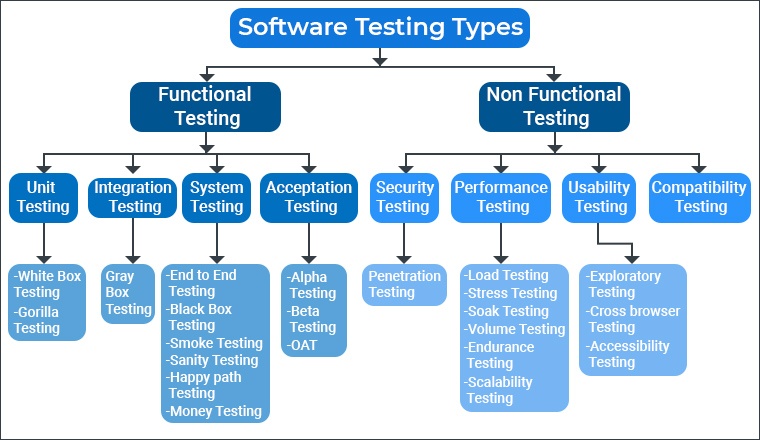
The quality of a software product is always a priority for business and not an option. So ideally, when a business is considering maintenance, you must place the best software testing strategies in place. Making quality and performance an indispensable part of a quality assurance program brings software testing services in focus for many businesses. There are multiple types of software testing like agile testing, automation testing, unit testing, usability testing, acceptance testing, security testing, sanity testing, smoke testing, compatibility testing, ad hoc testing, integration testing, performance, and several other so types of software testing too. It is time to explore all types of software testing and get to know which one will help us resolve which type of flaws. So, let’s get started.
1.1 Functional Testing and Non-Functional Testing
Testing has two major categorical bifurcation
- Functional Testing
- Non Functional Testing
Let’s see what each of these technical aspects stands for.
1. 1 Functional testing
Functional testing ensures that a software application’s functionalities are as specified in the requirements. The key differentiator of Functional testing is that it does not rely on the application’s source code. You can check the User Interface, Database, APIs, Client/Server applications, as well as the security and functioning of the program under test, verify if all options are available or not. You can do Functional testing either manually or with the help of software i.e automatically.
1.2 Non-Functional Testing
Non-functional testing examines the application’s non-functional characteristics, such as performance, usability, and dependability among others. You can perform tests in this section that have an influence on the basis of what affects the performance of the application. There are multiple ways you can analyze the non-functional aspects of business apps with software testing.
The initial black box testing and white box testing also had these functional testing imbibed in it. The perception of ways are different but it has the same agenda of making application bug-free and high-performing. Let’s get deeper and understand each type of software testing.
2. Types of Functional Testing
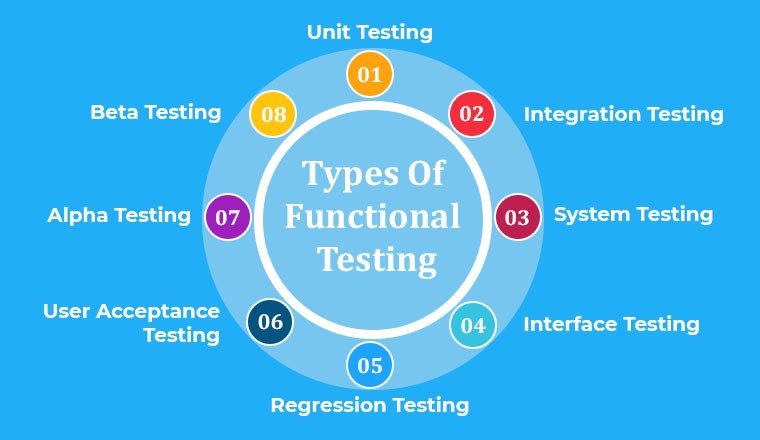
2.1 Unit Testing
Unit tests are done in many steps as rightly highlighted in the tweet below. It is one of the most important types of software testing.
As a developer, you write code. Unit testing is the software development practice of writing additional code, called unit tests. Learn why testing helps you create better software and how to run various unit tests. https://t.co/PQ4mCeTbxH pic.twitter.com/6BYmCYIKIt
— Trailhead (@trailhead) September 23, 2019
In unit testing, individual units or components of software are tested. In this type of software testing, each unit is minutely observed and analyzed. The goal of Unit Testing is to ensure that each component of the software works as intended. A unit is the smallest possible unit of software that requires testing. It generally just has one or a few inputs and one output.
Programmers/ developers carry out this process and not the testers. Because it encompasses each code of testing which is equivalent to coding again if testers do that. Hence, developers perform this type of unit testing.
Example of Unit Testing- Python unittest – unit test example
2.2 Integration Testing
In integration testing, individual components are integrated and tested as a group. This level of testing is designed to reveal flaws in the interaction of integrated units.
There are different ways of approaching the integration tests of your software development life cycle. It can be through top down approach, big bang approach or Sandwich/hybrid.
Integration testing example from Simplilearn
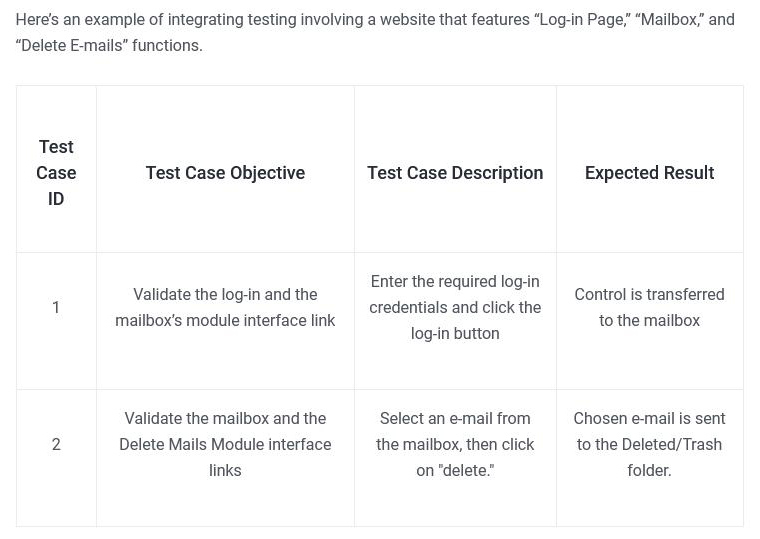
2.3 System Testing
In the software testing phenomenon, system testing plays an equally important role. You perform this type of testing to check whether the system meets the standards and accordingly match up the system standards. This performs end-to-end testing where there are system plans, system test cases and system tests. You can use various software testing methods to test the system and perform functional testing and you can also use different types of testing tools.
Here is an example of system testing from Quora:
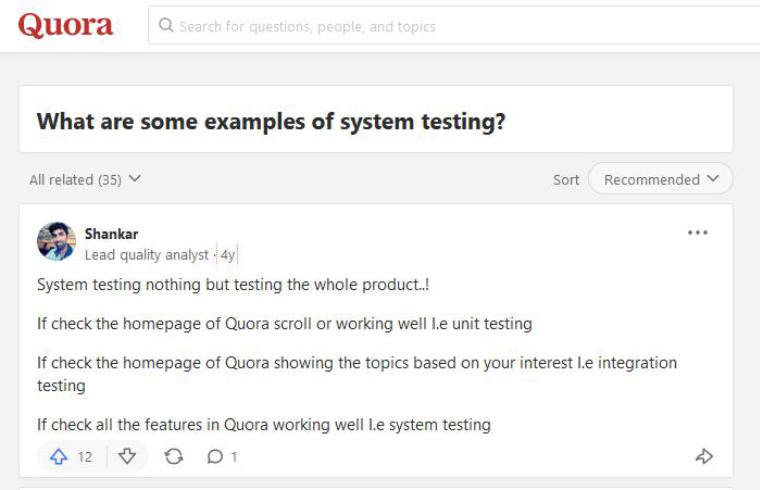
2.4 Interface Testing
As rightly said in this tweet, User interface testing sets the ground for usability on your websites, web apps, and mobile applications.
User interface testing sets the ground for usability on your websites, web apps, and mobile applications.
— BrowserStack (@browserstack) August 25, 2022
Learn how 👉 https://t.co/VofEeb088m pic.twitter.com/yAyupkcHXa
Interface is basically the platform that connects the back end side of functioning and front end side of the developed application. You can test the user interface of an application during user interface testing. The purpose of user interface testing is to ensure that the user interface is built in accordance with the requirements specifications document. When you see an application running successfully with great UIs, the reason behind it is strong interface testing that has made the application robust and secure to perform in any environment.
2.5 Regression Testing
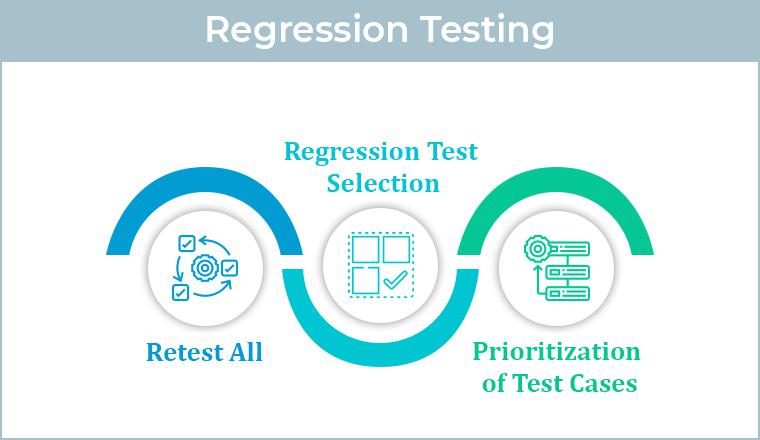
Regression testing is an important step for a product’s development and is highly helpful for developers in determining the product’s stability whenever there are modifications in need. Regression testing ensures that a software update does not affect the product’s current functioning. The regression testing allows developers to build tests, till the application is bug-free. Regression testing blindly follows a few techniques such as retest all where there is retesting of the whole app till it becomes error-free. Here the execution of Regression test case prioritization is as per priority, criticality and its implication on the developing application. After this step, you can ensure that the developed app is all set to break into the market. Now at this point majorly, all the tests are completed and all the errors are also addressed.
Example – https://www.testim.io/blog/regression-testing/
2.6 User Acceptance Testing
Acceptance Testing is a type of software testing that examines the acceptability of a system. The goal of this test is to determine whether the system meets the business requirements and whether it is suitable for delivery. User Acceptance Testing determines whether or not the software can be accepted by ensuring that it fulfills all of the client’s criteria and if it is not then it is sent back to the developers to accurately check the requirement sheet and make sure you meet the unmet requirements. Later, it will again undergo the same regression testing to make sure everything is in place.
Example – https://usersnap.com/blog/user-acceptance-testing-example/
2.7 Alpha Testing
Alpha testing is a type of testing that looks for all of the software’s faults and problems. You can carry this type of test towards the end of the app development process, before the product launch or delivery to the client, to guarantee that the user/client receives an error-free software program. Alpha testing comes before beta testing, therefore you’ll need to do beta testing after you’ve finished with alpha testing. Alpha testing isn’t done in a real testing environment. Instead, carry these assessments in a virtual environment that closely matches the actual world.
Here is an image showing the 7 criteria to start Alpha Testing:
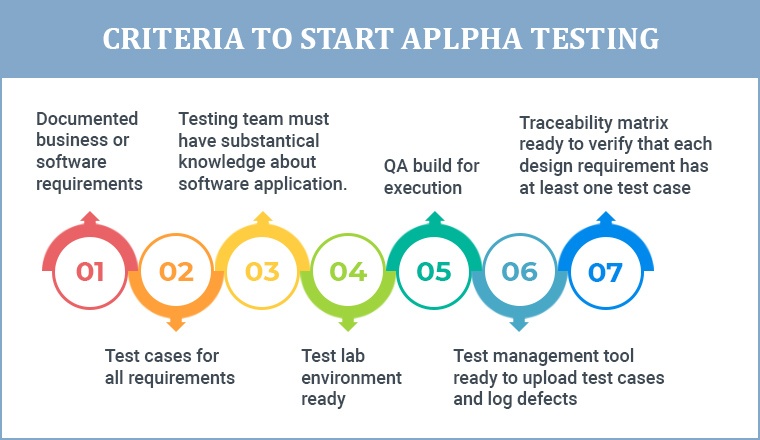
2.8 Beta Testing
This test is conducted in small numbers of actual customers or users in a real-world setting to ensure that the program is error-free and runs smoothly. You can make improvements to the software after gathering input and constructive criticism from those users.
Here is an image showing the 7 criteria to start Beta Testing:
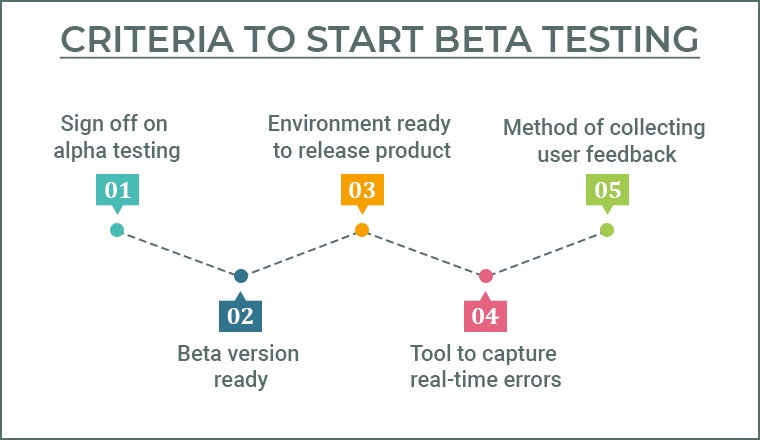
3. Types of Non-Functional Testing
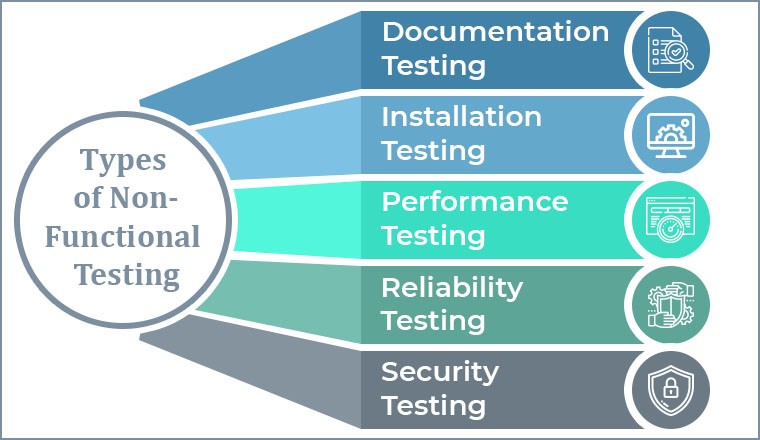
The fundamentals of software testing remains unchanged and there are businesses who take functional testing as well non- functional testing at equal importance. We have already seen how functional testing works and what its types are. Now, when it comes to non-functional testing, its primary function is to put the applications under test, based on load, how they perform in terms of performance, reliability, usability, and scalability among other things. Non-functional testing such as load and stress testing is commonly performed with the use of test automation tools and solutions like LoadView.
3.1 Documentation Testing
There is a document in preparation for the test to pass smoothly. With documentation testing aids in the estimation of testing effort and coverage. The test strategy, test cases, and requirements section are all included in the software documentation. Check almost all types of documents, examples, methods, and samples as input in the document are legit or not. If not, modify it and correct it.
Here’s a schema implementation in the functional-style JSON API endpoint.
Here’s an functional-style JSON API endpoint in a Rails app. The schemas do lots: input validation/coercion, auto-generating Swagger documentation, testing response bodies in specs, descriptive errors in test/prod. DHH would probably hate it, but I think it’s working well. pic.twitter.com/sy7Ukp7moZ
— Tom Dalling (@tom_dalling) April 17, 2019
Example – https://doc.rust-lang.org/rust-by-example/testing/doc_testing.html
3.2 Installation Testing
In the software business, installation testing is a form of quality assurance work. This has its major focus on what consumers will need to do at the time of installation and set up new software. It could be anything from a third-party backup app, link description, or any other essential needs. It can be full, partial, or upgrade type of install/uninstall operations may be part of the testing process. This is a non-functional need but without this the installation process won’t succeed.
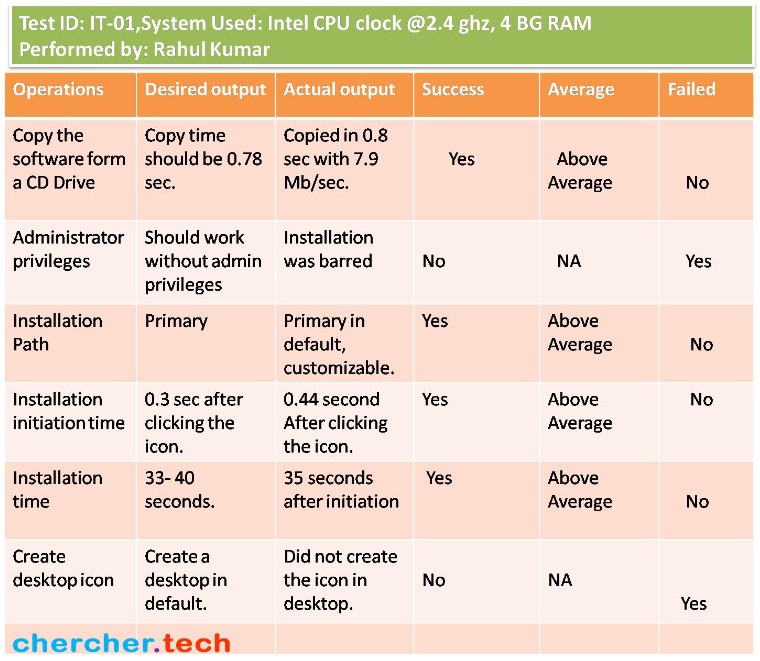
All you must take care when you design an installation procedure is the path to installation of the full version of application, automate testing efforts, disk space, distributed testing environment, validate other registry changes after installation and finally uninstallation testing.
Example – https://www.advancedinstaller.com/application-packaging-testing-process-guide.html
3.3 Performance Testing
Performance testing determines whether or not the program is performing well as per the expectations. There are performance testing tools that assess the performance of your app and show you where the problems are. You may improve the performance of your software program by addressing these concerns.
The general objective of this performance testing is to compare an application’s performance to different operating systems and network benchmarks such as CPU utilization, page load speed, peak traffic handling, server resource consumption, and so on. There are numerous different forms of performance testing, such as load testing and stress testing. Following are the 4 essential types of performance testing.
Example – https://www.tatvasoft.com/blog/guidelines-for-software-performance-testing-with-apache-jmeter/
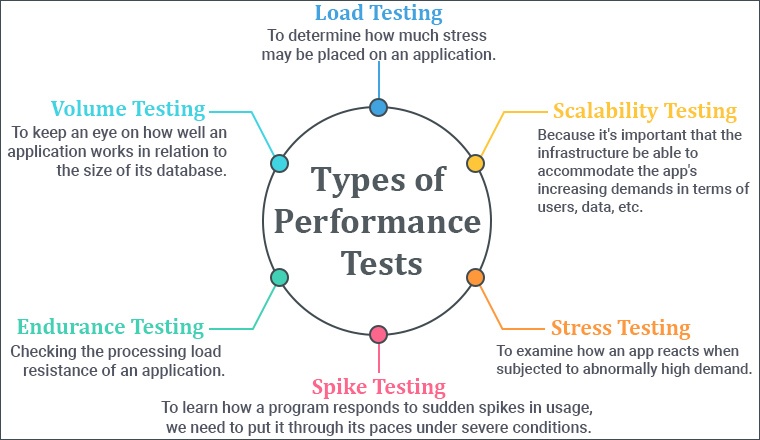
3.3.1 Load Testing
Load testing is a type of performance testing that determines how much load a system can withstand before its performance degrades. You can determine a system’s load capacity by performing load testing. If your developed application is able to take the amount of audiences targeted at a single time then the load test is successful. Unit tests are performed here to understand how much is the load at each feature and how you should resolve it to make it a seamless performer.
3.3.2 Stress Testing
Stress is another type of performance testing that ensures the maximum limit of load that can be applied on a website or application. This type of software testing ensures the feasibility of the application or website or any software and how it can be addressed.
3.3.3 Endurance Testing
This type of testing is continuous testing measures a specific type of workload given applied consistently on the website. Based on this, you can make the decision of the estimation of users and concurrent users using these apps.
3.3.4 Spike Testing
For specific business scenarios when there is an unexpected user intervention or load applied in any other form on application. This is a precautionary measure to understand how the app reacts when the load is low.
3.4 Reliability Testing
Reliability testing ensures that the product is free of flaws and capable of performing its intended function.It’s all about testing an application to find out whether it has any flaws before deploying it. Each function in the software should be run at least once as part of the feature test. In addition, there should be less interaction between two or more functions. Within the reliability test, you can also perform regression tests whenever there is an addition of a new functionality or deletion of old functionality. This is to ensure there is no entry of new issues in the system.
Before setting the reliability testing objectives, you must mark certain restrictions such as software behavior under certain testing environments, attainable targets, and time.
3.5 Security Testing
As a software testing practice, you must consider security tests to be the first thing. There are multiple ways you can maintain the security of the application. Security testing is a type of software testing that guarantees that an organization’s systems and applications are free of flaws. The goal of security testing is to identify any system flaws that might lead to data loss or bad market reputation.
4. Other Aspects of Manual Testing Vs Automated Testing
Manual or Automated- both these types of software testing just defines the speed and the precision with which the testing is done. As simple as it sounds, there are so many different aspects that make both these types of software testing different from each other.
4.1 Manual Testing
Manual testing is done manually by a testing team by exploring and interacting through the developed application.The tester gets a chance to interact with software, APIs and all other necessary functions where flaws can be identified and resolved. You can use appropriate tools which will help you identify the bugs easily and at an early stage.
This method seems to be tedious and expensive too. If the project is bigger, you might need to add more resources, spend on infrastructure, hiring and training costs are additional. As this requires a proper set up, it is quite obvious to make human mistakes which might later affect the overall output of the app.
Example – https://www.srijan.net/resources/blog/manual-api-testing-using-postman
4.2 Automated Testing
The concept of automated testing was brought into picture to level up the game of manual testing. How to improve your manual testing skills is not the question here, the primary aspect here is how automation or automated testing works. Automated testing is carried out by a machine that runs a pre-programmed test script. The complexity of these tests might range from checking a single method in a class to ensuring that completing a sequence of complex actions in the UI produces the same results.
Automated testing uses programs to run and check the errors in the software or developed app. The efficiency cannot be questioned and the speed too. It is far more robust and dependable than manual tests, yet the quality of your automated tests is determined by how well your test scripts are written.
Example – https://www.lambdatest.com/blog/getting-started-with-selenium-python/
5. Exploratory Testing
This type of software testing might sound new to many but this is there for years. This “after testing” method is used to explore more features using testing. However, more features and enhancements can be explored using “Exploratory testing”. Infact, you can add this testing to your code, the more testing you’ll need to do to ensure that everything functions properly.
This will also help developers to take pre steps for each bug you repair, double-check if thats done or need any reappear in later releases. Automation is essential to making this happen, and creating tests will eventually become a part of your development workflow.
So the question is whether manual testing is still worthwhile. The simple answer is yes, and it should be focused on exploratory testing, which seeks to find non-obvious mistakes. An exploratory testing session should not last more than two hours and should have a clear scope to assist testers in focusing on a specific topic.
Here’s an explanation from Quora on why you require Exploratory Testing:
Example – http://thatsabug.com/blog/postman_async/
6. Conclusion
This extensive blog is a highlight of all types of software testing you need for any business. May it be any industry or sector, these are the major types of testing which will help you create a bug-free, performing and top-notch application. We have tried and put forward all the essential points that will help you use these in software development and software testing techniques and practically imply it. Your app is different so the needs of testing will be different but don’t consider testing an option just because the process is not the same for all. To lead a successful app, testing is a necessity.




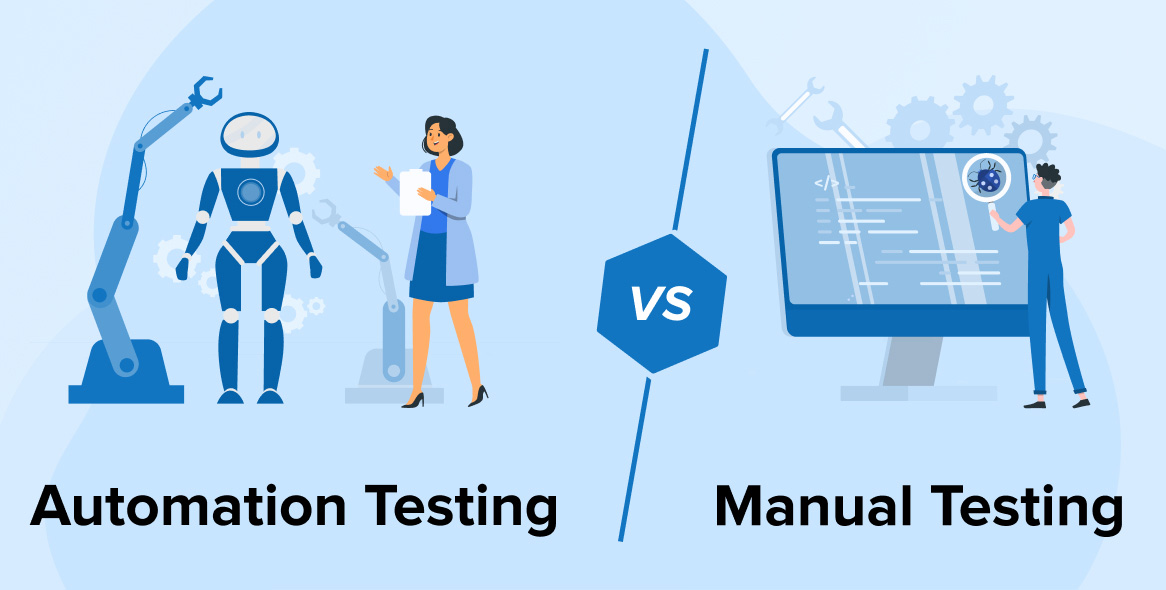

Software testing is the most important part of the software development life cycle. there are several types of software testing that ensure the software quality standards. Here mentioned each testing types perform different roles in the software testing life cycle. Looking forward to more of this type of informative article.
Different type of testing, from functional to performance, security, and usability tests, is essential to making sure the software is stable, bug-free, and easy to use. The development process may be improved by including several testing kinds to produce high-quality software that meets user expectations. Thank you for sharing useful insights on types of software testing.
I appreciate the explanation of the types of software testing. This article also contains helpful links to other resources, which is great for better understanding. If you are looking for better resources to learn about the types of software testing, this article is great for you.